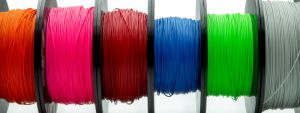Filament Temperature Resistance in FDM / FFF 3D printing
The temperature resistance of the filament has always been the issue that pushes the world of 3D printing and FDM / FFF technology forward. I even dare to say that - the temperature resistance of the filament, determines and drives development. However, in order to explain it precisely, one publication or one statement is not enough, because it is a vast topic. In this publication, I will outline some basic parameters, explain the issues related to the temperature resistance of filaments and present the ranking of filaments profiled on printers from Omni3D.
Moving in the world of FDM / FFF, we will meet the concept of filament temperature resistance at every step. To explore this issue, we need to know the concepts related to it and explain what they really mean and how they translate into the printing itself and the use of given elements in further processes. There are many concepts and each manufacturer defines them a bit differently, therefore it is difficult for some users to actually identify the correct parameters. I will try to introduce You to this topic a little more.
What is Glass Transition Temperature – TG?
In simple words, it is the temperature above which the stiffness of the material drops sharply. What does this knowledge give us? This temperature is very often responsible for the correct selection of the bed temperature, and in simple words it is the temperature around which the force with which the material adheres to the printer bed is the greatest. Understanding, knowledge and use of this issue gives the user greater control over warping during printing. The problem may be that the data provided by the manufacturers concern the filaments, in perfect condition (dried, no degradation) – this means that very often these parameters are difficult to determine and the printer setting is still more intuitive.
What is Melting Point (about to printing temperature)?
This is the temperature around which the material becomes liquid. In most cases, however, the polymer melt is still too viscous to print freely. For this reason, the printing temperatures recommended by the manufacturers are usualy higher. It is a parameter whose proper setting, and what is more, proper control of the temperature stability of the nozzle determines the quality, precision and durability of the printed element. Manufacturers provide a certain temperature range that the user must check and properly select. Proper filament storage becomes an important element again. Knowing about it and using it properly can significantly influence the result You want to achieve and personalize the final result, it is more than just printing.
Read: Large-size 3D printing
What is Heat Deflection Temperature HDT?
To quickly and clearly explain this concept – I will name this „point” and the another „Tests”. Because these are strictly defined conditions under which certain changes take place. HDT (Heat Deflection Temperature) is a form of checking how the product will behave in conditions of increased temperature under a specific load. This parameter is important and determines the use of a given material per element for a given application. Knowing this and its proper use, as in each of the above aspects, makes our printout useful and personalized to specific needs. This test is strictly described in ISO75 standards and ASTM D 648 measurement standard, which we can always refer to and check.
Read: 3D printing of spare parts
What is the Vicat Softening Temperature?
This parameter, like the above, is the result of the test and is strictly defined in the ISO 306 (ISO 10350) standard and the ASTM D 1525 (or B50)which is a measurement standard. Again, as in the above, this test gives the answer at which temperature a given element changes its properties. More precisely – at what temperature the „needle” with an area of 1 mm2, with a certain load force, will go into the product to a depth of 1 mm. Unlike HDT – Vicat test – or softening point. – very often, this temperature is close to the liquefaction temperature (melting temperature) and, what is important, especially in the case of industrial – semi-crystalline – filaments of the type: PEEK, PEKK, ULTEM – significantly different from the deflection temperature (see the table below). Proper knowledge on this subject and its use gives the engineers the opportunity to further personalize the printout for their needs and use.
Knowledge about the thermal properties, temperature resistance of filaments and the printouts themselves is an important part of the life of a 3D printer user. Understanding the parameters and their proper use gives everyone a great advantage and allows You to take advantage of the opportunities offered by 3D printers.
Ranking of selected profiled filaments for Omni3D printers
| Filament | Glass Transition Temperature | Printing temperature | Heat Deflection Temperature | Vicat Softening Temperature |
| PLA | 63C | 190-230C | 49-55C | 63C |
| Pet G | 80C | 210-230C | 63C | 78C |
| ABS-42 | 88-100C | 235-255C | 88-100C | 94C |
| Pa6/66 | 50-80C | 240-260C | 65-105C | 200C |
| ABS-PC | 120-127C | 255-270C | 95-105C | 110C |
| CFPA12 | 100-110C | 240-260C | 154-169C | 173C |
| Thermec Zed | 210C | 310-340C | 200-210C | 220C |
| PEKK -A | 159C | 308C | 145-154C | 305C |
| PEKK CF | 160C | 350-390C | 280-360C | 340C |

If you want to know more about filaments from Omni3D DOWNLOAD FILAMENT CHARACTERISTICS AND APPLICATIONS TABLE or contact an Omni3D specialist!

